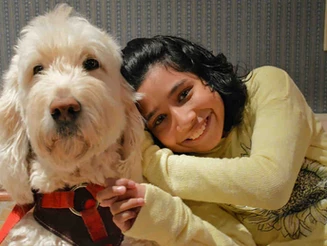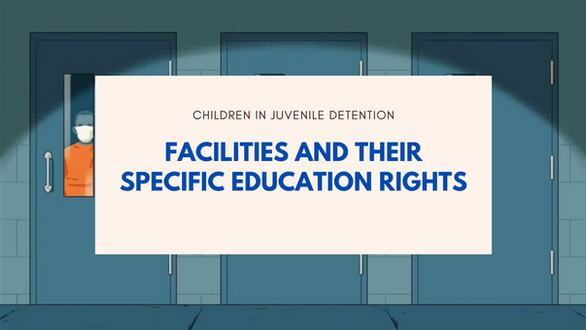The mandates of the Individuals with Disabilities Education Act (IDEA) require that schools provide every student with a Free and Appropriate Public Education (FAPE). The Rehabilitation Act, better known as Section 504, “provides that schools receiving federal funds cannot deny disabled students access to their programs and facilities.”(1) In certain cases, a service dog is a reasonable accommodation under the IDEA and Section 504. An “appropriate education” as defined by Section 504 includes “regular or special education and related aids and services that are designed to meet individual educational needs of handicapped persons as adequately as the needs of non-handicapped persons are met.” This includes the use of service dogs, which are specifically trained to help individuals with disabilities, by students who are in need.
The tasks of service animals in public places include guiding people who are blind, alerting people who are deaf, pulling a wheelchair, alerting and protecting a person who is having a seizure, and more. Service animals are distinct from therapy dogs and emotional support animals, which do not have the same training or certification. The National Association of School Nurses explains that “schools have a legal responsibility to provide planning and services for children with special healthcare needs, including allowing service animals into schools. Planning promotes quality care for students with special healthcare needs in school and enhances the student’s academic success.”(2)
1.) Gerstein, R. & Gerstein, L., Education Law: An Essential Guide for Attorneys, Teachers, Administrators, Parents and Students, Second Edition. Tucson: Lawyers & Judges Publishing Company, Inc. 2007.
2.) Duncan, K., Garret, J., Strasser, K., & Teskey, C. “Service Animals in Schools.” The National Association of School Nurses. June 2014.
Students with disabilities are entitled to an Individualized Educational Program (IEP), and if the child requires a service dog, it is a reasonable accommodation to include. The presence of service dogs is known to alleviate anxiety for many students. Boris Levinson, one of the first researchers on the way service dogs can help children with emotional and behavioral disorders and autism, has found that animals could be a catalyst in therapy and could help children better connect to reality.”(3) This is further confirmed by a report by Disability Rights Ohio, which explains that “a teenager with social phobia and separation anxiety can use a service dog as a transitional support so he or she can go to school.”(4) Service dogs are specifically trained to see the signs of a panic attack before it occurs, and remind the owner to take their anxiety medication. As such, if a child uses a service dog for therapeutic or physical purposes, their IEP should include their service dog.
As outlined by the IDEA, parents are entitled to a due process hearing in a court of law in the case that they feel that their child’s IEP is not adequately fulfilling FAPE. The leading case on the subject of service dogs in school is Fry v. Napoleon Community Schools, in which a student with cerebral palsy was not permitted by her school to bring her service dog. Ehlena Fry had been prescribed the service dog since 2008, and her parents “allege explicitly that the school hindered Elehna Fry from learning how to work independently with Wonder, and implicitly that Wonder’s absence hurt her sense of independence and social confidence at school.”(5) As part of Fry’s IEP, the school had provided her with a human aide, which could not help her the same way her service dog did. The Court of Appeals for the 6th Circuit ruled that the school was not in violation of the IDEA, since the parents failed to request a special education due process hearing before suing for monetary compensation. However, on February 22, 2017, the Supreme Court of the United States reversed the Court of Appeals decision and ruled in favor of the parents. Given this pivotal decision, the law aligns with Fry’s parents’ in confirming that an IEP must include accommodations that help a student feel more comfortable and confident participating in school activities. In Ehlena Fry’s case, her service dog “functions as an access ramp—not just in terms of the school building but, more significantly, in all aspects of her life,” and as such, the service dog’s presence at school was covered by the IDEA and Section 504.
3.) “9 Things to Consider Before Getting a Service Dog for Your Anxious Child.” Comforting Anxious Children. 1 February 2017.
4.) “Special Education: Service Dogs.” Disability Rights Ohio.
5.) Stacy Fry and Brent Fry, as Friends of Minor E.F. v. Napoleon Community Schools. 2014-2015.
In the 2007-2008 case Cave v. East Meadow Union Free School District, one argument against the student’s service dog’s presence in the classroom was the risk that other students would be allergic to the dog. However, according to the ADA, “allergies and fear of dogs are not valid reasons for denying access or refusing service to people using service animals.”(6) Furthermore, the ADA states that “when a person who is allergic to dog dander and a person who uses a service animal must spend time in the same room or facility, for example, in a school classroom,” the school should accommodate both parties “by assigning them, if possible, to different locations within the room or different rooms in the facility.” It follows that children who require a service dog for their everyday lives, and thus for their educational success, must have IEPs tailored to include their service dog and the proper accommodations necessary.
Service dogs are a reasonable accommodation under the IDEA, which requires schools to help students with disabilities to receive FAPE by means of an IEP. If a student has a service dog to help them cope with their disability on a daily basis, this student is allowed by the IDEA to bring the dog to class.
6.) “ADA Requirements: Service Animals.” U.S. Department of Justice. Civil Rights Division: Disability Rights Section. 15 September 2010.











